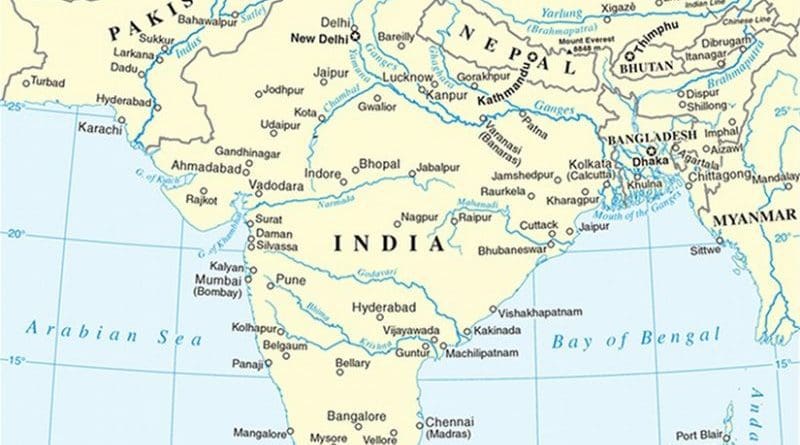South Asia: Regional Integration And Greater Economic Freedom Will Boost Growth And Prosperity – Analysis
By James M. Roberts and Huma Sattar*
South Asia is one of the fastest-growing regions in the world, with average gross domestic product (GDP) growth projected to be 7 percent in 2015 and well above 8 percent by 2020. India is the bright spot in the region, with 8 percent GDP growth projected by 2018, spurred by 12 percent growth in investment as the country continues to shift from consumption to investment-led economic development.[1] The recent steep decline in global oil prices in this heavily oil-import-dependent region has been the catalyst for this growth and is helping to bring price stability to regional economies with lower inflation, decreased fiscal deficits, reduced electricity-generation costs, and, consequently, reduced energy-subsidy burdens for regional governments. That means that more money is available for investment in infrastructure and other public goods.
Home to 1.7 billion people, South Asia has the world’s largest working-age population. Although the majority of its people work in the agriculture sector, the share of the labor force in services has increased significantly in the past few years. Overall, the region’s flourishing services sector has been the main driver of economic growth (accounting for about half of the growth of GDP), whereas the contribution to GDP growth from the industrial sector has been nominal.
Average annual inflation for the region (as reported by the Asian Development Bank) remained “subdued as economic slack and low global food and commodity prices contain[ed] price pressures” such that the rate dropped from 6.2 percent in 2014 to 5 percent in 2015.[2] Remittances sent home by South Asian citizens working abroad are important contributors to regional economies, accounting in 2013 for nearly 30 percent of Nepal’s GDP, more than 9 percent each for Bangladesh and Sri Lanka, and 6 percent for Pakistan.[3]
Although the region’s GDP projections are rosy for the next five years, this promising scenario may not be sustained over the longer term if South Asian countries fail to exploit the unique opportunities that low oil prices and relatively free global markets present to them today. Countries in South Asia have a window open to them now that affords a chance to address the fundamental structural problems and regulatory inefficiencies that have obstructed optimal economic growth in the region in the past and simultaneously have discouraged regional economic integration.
The urgency of the need for new policies to stimulate economic growth is all the more poignant because the region as a whole remains plagued by extreme poverty. A quarter of South Asia’s population lives below the poverty line (defined as less than $1.25 a day)—the largest share of poor people among all regions of the developing world. In fact, 40 percent of all people trapped in extreme poverty worldwide live in South Asia. More than 40 percent of Bangladesh’s population alone is extremely poor, compared with nearly a quarter of people in Nepal and India.[4]
Corruption is another huge concern in South Asia—especially in public institutions—which creates an unfavorable business environment for foreign investors and has been the primary reason why the growing South Asian economies have remained mired in poverty.[5] Surveys show that 80 percent of people in the region believe the governments in their countries do not take effective action to fight corruption.[6]
Economic regional integration has been a casualty of political conflict, with the long-running Pakistan–India dispute over the territory of Kashmir since 1947 and disturbances at the Line of Control (LoC) largely preventing regional integration. Both countries have focused on strengthening bilateral economic relations with other regional partners, pushing their relations with each other to the back burner.
The geopolitical importance of South Asia, shared borders with Central Asia and the oil-rich Gulf, its natural resources, and its human capital make the region’s potential for growth enormous. The countries must open their markets and lower barriers to trade and investment, especially to regional partners, while improving economic freedom with a deliberate focus on strengthening rule of law, eradicating endemic corruption, and reducing bureaucratic regulations that harm businesses and investors.
This Special Report examines in detail the levels of economic freedom in five of the eight South Asian countries—India, Pakistan, Bangladesh, Nepal, and Sri Lanka—that together account for a majority of the region’s GDP, discussing those areas that in the past have hindered the sustainable development of economic freedom and greater, more widely shared prosperity. In so doing, the report identifies opportunities for regional integration within South Asia that would provide additional impetus for these countries to achieve the economic growth now being enjoyed by other world regions that have made, and continue to make, steadier progress toward eradicating poverty and improving the livelihoods of their peoples.
I. South Asia: Very Gradual Improvement of Economic Freedom
Economic freedom scores for South Asian countries, as measured in the 2016 edition of the Index of Economic Freedom, published by the Heritage Foundation and The Wall Street Journal, have improved and are moving (albeit slowly) toward the “moderately free” status accorded emerging-market economies such as Kazakhstan, Thailand, and the Philippines.
India and Bangladesh have achieved the most progress, rising from “repressed” (the lowest Index category) in 1995 to “mostly unfree” in the 2016 edition, with scores of 56.2 out of 100 and 53.3, respectively.
Pakistan, too, with a score of 55.9 has demonstrated improvement and, while remaining “mostly unfree,” appears to have achieved some positive momentum.
Nepal continues to lag behind, with a “mostly unfree” score of 50.9 that is just slightly above the “repressed” threshold. Sri Lanka, while remaining the freest economy in the region with a score of 59.9, has actually lost ground overall and is now less free than it was when the Index was first published in 1995.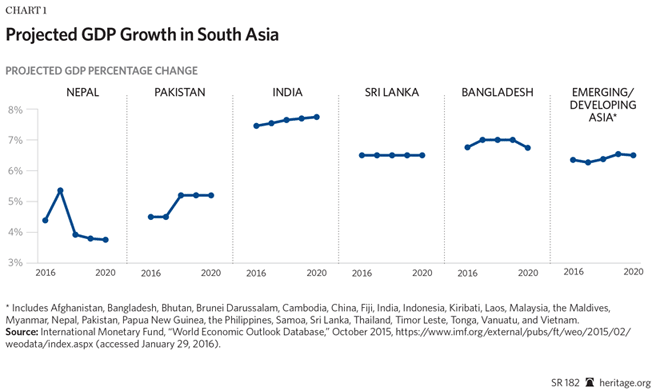
All countries in South Asia remain below the world average of 60.7, and all but Sri Lanka are below the average for the Asia–Pacific of 59.0.[7]
Today’s Scores on Economic Freedom Will Determine Tomorrow’s Growth. In the past few years, South Asia has emerged as a growing economic region with great potential for further growth. In its South Asia Economic Focus report,[8] the World Bank called the region the fastest growing in the world during the last quarter of 2014, and credited India’s business-oriented reforms and improved investment environment, along with the sharp drop in world oil prices, with being the primary cause of that growth. The report projects steady growth of from 7 percent in 2015 to 7.6 percent by 2017 and predicts a steady increase in investment. An International Monetary Fund report projects similar growth patterns for Bangladesh, India, and Sri Lanka, with Nepal and Pakistan lagging behind at 4.4 percent and 5 percent growth, respectively, by 2020. GDP per capita, on the other hand, does not show massive improvements, with the region averaging growth of GDP per capita at between 4 percent and 5 percent since 2011.
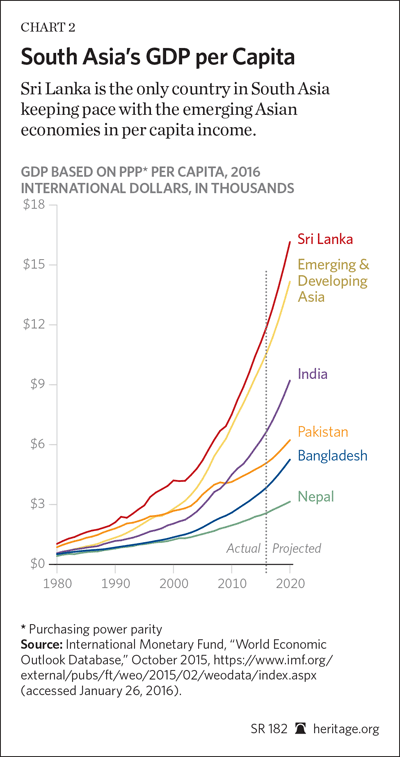 In fact, while modest improvements in trade freedom, business freedom, fiscal freedom, monetary freedom, and government spending for the region have improved prospects for growth, other indicators, such as poor rule of law and corruption, lack of investment opportunities, and insufficient business freedom continue to limit economic growth and human capital development in South Asia as compared to other emerging and developing countries in the greater Asia region. As it stands, regional scores on the United Nations’ Human Development Index place South Asia just slightly ahead of Sub-Saharan Africa (0.502) with a value of 0.588 versus the world average of 0.702.[9]
In fact, while modest improvements in trade freedom, business freedom, fiscal freedom, monetary freedom, and government spending for the region have improved prospects for growth, other indicators, such as poor rule of law and corruption, lack of investment opportunities, and insufficient business freedom continue to limit economic growth and human capital development in South Asia as compared to other emerging and developing countries in the greater Asia region. As it stands, regional scores on the United Nations’ Human Development Index place South Asia just slightly ahead of Sub-Saharan Africa (0.502) with a value of 0.588 versus the world average of 0.702.[9]
Overall, South Asian countries face similar challenges—and hence have similar solutions. The World Economic Forum, in its 2015 Global Competitiveness Index, blames poor economic mobility in particular, with a deficit of infrastructure development and poor regional connectivity, excessive red tape, and pervasive and deep-rooted corruption as some of the common reasons for the dismal competitiveness of this group of countries.[10] Whereas India and Sri Lanka achieved moderately competitive rankings of 71 and 73, respectively, out of 144 countries, India’s score has been on a downward spiral. Nepal (102) and Bangladesh (109) have improved their rankings but remain among the least competitive countries both in the world and among emerging Asian countries. Pakistan, with the lowest ranking of 129, improved somewhat compared with its previous rank of 133.
A few South Asian countries in particular are laggards. Nepal’s earthquakes in 2015, for instance, inflicted widespread devastation not just in terms of loss of life and property damage, but also to its already feeble economic infrastructure. The earthquakes killed over 10,000 people and damaged many national heritage tourism sites. By some estimates, total economic losses could exceed the country’s annual GDP of $19 billion. These losses have cast a harsh spotlight on the structural impediments that have plagued the country for centuries.[11] Absence of rule of law, corruption, flimsy democratic processes, low freedom for investments, and poor governance have combined to make it more difficult for the country to revive in the aftermath of a series of natural catastrophes.
II. Persistent Structural Deficiencies Thwart Sustainable Growth
Endemic Corruption Has Long Plagued South Asia. As far back as 2002, a study conducted by Transparency International (and repeated for subsequent reports) found South Asia to be fraught with heavy corruption in public institutions, which, combined with a lack of effective monitoring systems, undermined economic growth, reduced efficiency, acted as a disincentive to potential investors, and, above all, diverted critical government resources that could have alleviated poverty.[12] According to the survey data published with that study, access to public services in South Asia—especially Pakistan, Bangladesh, and Sri Lanka—was denied to the lowest income strata due to corruption. Moreover, extensive levels of bribery and extortion translated into high levels of income erosion in those countries. Meanwhile, a severe lack of accountability and systematic abuse of political power by privileged elites ensured that the corruption only worsened.
The situation has not changed much since then: South Asia remains the world’s most corrupt region, and that has proven to be a barrier to development and poverty eradication. A survey conducted by Transparency International in 2010 and 2011 reported that nearly two-thirds of people across the region believed corruption in public institutions had increased since 2008. In India, about three-quarters of the population believed that corruption increased between 2007 and 2010.[13] Transparency International’s 2014 Corruption Perceptions Index[14] again ranks the South Asia region very low and reports little improvement. India and Sri Lanka are ranked as the least corrupt among their peers, tied for 85th place out of 174 countries (with a score of 38 of 100); Nepal and Pakistan stand at 126 (with a score of 29 of 100); and Bangladesh ranks dangerously low at 145 (with a score of 25 of 100), where a score of less than 50 indicates a serious corruption problem.[15]
A 2014 report by Transparency International on corruption in South Asia cites lack of accountability as the primary reason why corruption continues unabated. The report argues that “South Asia’s corruption epidemic is caused by opaque public institutions, lack of protection for anti-corruption actors and widespread government interference in the work of anti-corruption watchdogs.”[16] Although right-to-information laws exist in some form or another in all of South Asia, the region’s residents either are not aware of these laws or are sufficiently harassed by public agencies to refrain from pursuing information. In some cases, anti-corruption agencies—particularly in India, Nepal, and Sri Lanka—have been accused by transparency advocates of merely being used by those in power for old-fashioned score-settling or even to persecute the political opposition.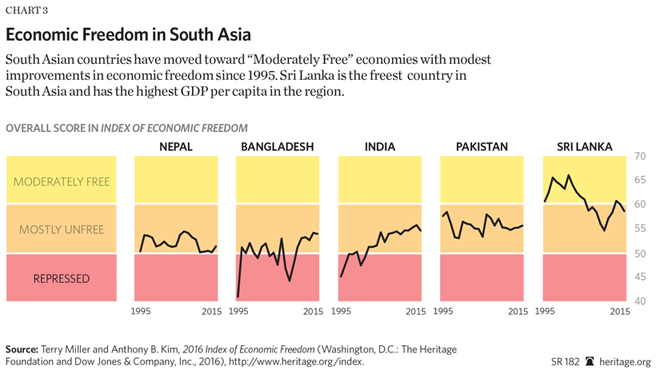
As the report notes:
The effectiveness of these supposedly independent accountability bodies is seriously undermined by systematic political interference and manipulation, either through deliberate restrictions on their powers to tackle corruption or through tight government control over appointments, transferals and removal from office of senior staff.[17]
In Bangladesh, ranked most corrupt in the region, the burden of petty corruption was estimated by Transparency International to amount to one-tenth of the national budget. Judicial watchdog organizations in the region are especially prone to a lack of independence and credibility.[18] The World Economic Forum, in its 2015 Global Competitiveness Index, cites rule of law, corruption, red tape, patronage, weak public institutions, and lack of property-rights protection as the primary reasons for the region’s poor competitiveness in the world.[19] Other surveys support this conclusion: 57 percent of business firms in Pakistan cited corruption as a major deterrent to trade and investment. Overall, as Transparency International’s “Global Corruption Barometer 2013” reported, two-thirds of the residents in South Asia are convinced that the level of corruption in their countries has been increasing rather than decreasing.[20]
Three Critical Areas in Need of Regulatory Reform. The 2015 Global Competitiveness Index identifies lack of structural reforms as the primary reason why most emerging economies, despite high economic growth, have neither increased their competitiveness nor boosted their productivity.[21]
The index points to three critical areas where reforms are needed:
- Strategic economic sectors (in particular energy sources and power generation, textiles, pharmaceuticals, and small and medium-size enterprises), which must be opened up to competition by removing bottlenecks and barriers to entry;
- Labor markets, which should be made more flexible and hence more efficient in making use of all available human capital; and
- Public administration, which must be overhauled in order to implement structural reforms effectively.
These structural reforms would improve not only competitiveness, but also the resilience of South Asian economies to withstand the impact of “future external shocks, allow a more efficient allocation of resources, and facilitate the transition toward more productive activities.”[22]
Overall, then, South Asian countries rank low on competitiveness due to corruption, excessive red tape, and an absence of long-overdue regulatory reforms that are crucial for businesses to flourish. The World Bank’s “Doing Business” survey analyzes how vital an efficient regulatory regime is to the conduct of business and identifies necessary improvements[23] in 10 regulatory areas, such as the ease of starting a business, obtaining electrical service, business taxation, and property registration.
For most of these indicators, South Asia ranks well below global averages and far behind the world’s most economically efficient countries. On a scale of 0 to 100, South Asia’s distance to frontier (DTF)[24] scores show the same dismal pattern, well short in such categories as access to credit, contract enforcement, ease of cross-border trading, and registering property.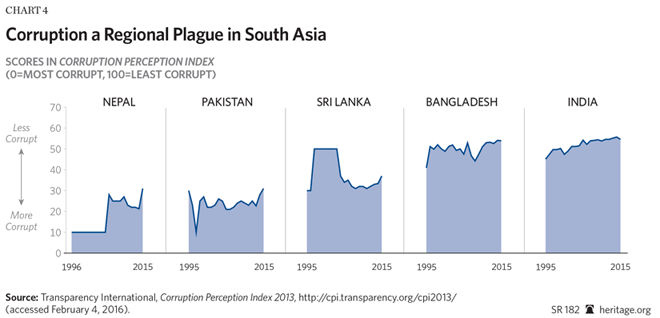
There have been some improvements: In 2015, Bangladesh made trading across borders easier by installing a fully automated customs data-management system; India made starting a business easier by reducing registration fees (then, however, offsetting that advance by introducing a requirement to file a declaration before the start of business operations); Pakistan made trading across borders better by introducing a unitary, Web-based customs application for submission and processing of trading documents. And in 2014, Sri Lanka introduced electronic payments systems for port services that enabled easier trade.[25] Unfortunately, these small, one-off improvements have all too often been canceled out by simultaneous imposition of other measures that make doing business more difficult.
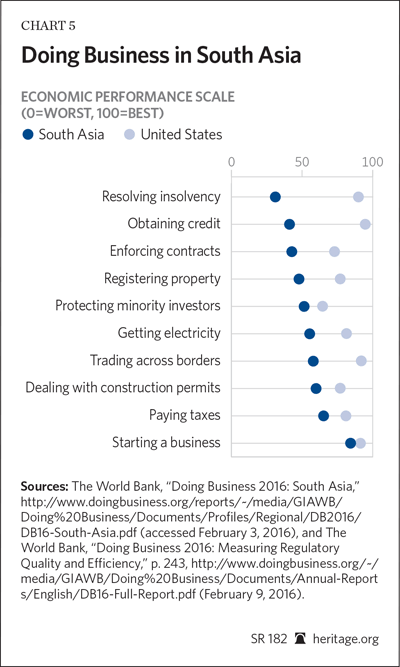 Trading Across Borders Is Difficult. Cross-border trade volumes in South Asia are significantly low compared to East Asia and the Pacific and other regions—largely due to regulatory inefficiencies. According to the “Doing Business” survey, it is costlier and more time consuming for businesses in South Asia to export and import than it is in most other regions. As a point of context, it takes an average of nearly 35 days to export or import from or to South Asia. By comparison, the Organization for Economic Co-operation and Development (OECD) average is 10 days; the average for East Asia is 21 to 22 days; and for the Middle East/North Africa (MENA) region, the average is 24 days.[26]
Trading Across Borders Is Difficult. Cross-border trade volumes in South Asia are significantly low compared to East Asia and the Pacific and other regions—largely due to regulatory inefficiencies. According to the “Doing Business” survey, it is costlier and more time consuming for businesses in South Asia to export and import than it is in most other regions. As a point of context, it takes an average of nearly 35 days to export or import from or to South Asia. By comparison, the Organization for Economic Co-operation and Development (OECD) average is 10 days; the average for East Asia is 21 to 22 days; and for the Middle East/North Africa (MENA) region, the average is 24 days.[26]
Unsurprisingly, transaction costs associated with export/import in South Asia are significantly higher: The average cost to ship one container of exports from South Asia is $1,922 compared to $864 in East Asia, $1,166 in MENA, and $1,080 in the OECD High Income group. By far, landlocked Nepal is costliest and most time-consuming for trade, whereas the island nation of Sri Lanka is one of the region’s better performers.
The Burden of Bureaucracy. Bureaucracy is a chronic nuisance in South Asia that makes routine commercial processes more difficult, costlier, and slower than elsewhere in the world. On average, it takes 16 days in South Asia to start a business, requiring about eight distinct bureaucratic procedures (much longer and more complicated than in OECD countries or even other emerging-market regions).
This is not to say that South Asian countries have not taken some steps to make starting a business slightly easier; India reduced its registration fees, while Bangladesh and Sri Lanka introduced automation to registration processes.[27] Other issues related to starting a business, such as acquiring electricity service, registering property, or obtaining construction permits, still require a significant number of days and procedures. To illustrate, it takes an average of 145 days for a new electricity hookup in South Asia as compared to 77 days in the East Asia Pacific and 76 days in OECD countries. In general, inefficient systems and bureaucratic procedures make it very difficult for new businesses to set up shop.
III. Higher Connectivity and Lower Trade Barriers Can Spur Growth
Gains from More Trade Freedom. The paradoxical nature of South Asia is that, while it remains the least integrated region in the world, it is also a region with continuously opening markets. Time-series data using trade freedom scores from the Index of Economic Freedom shows marked improvements for all the South Asian economies, all of them moving from “mostly unfree” into the higher “moderately free” category in recent years.
Imports as percentage of GDP show that South Asian countries are keeping up with East Asia and the Pacific and the high-income OECD groups in terms of opening their markets to international trade. South Asia’s global trade (exports plus imports) has increased considerably: from $118 billion in 2001 to $968 billion in 2014, whereas within the region, trade figures were stuck at a paltry $22 billion in 2014. India and Sri Lanka have improved their economies by moving from agriculture toward industrial bases: 31 percent and 32 percent of GDP, respectively. Both countries are now importing intermediate industrial inputs instead of finished manufactured products, and in the process, they are building local capacities and gaining economies of scale.
Despite their proximity advantages, however, South Asian economies tend to focus more of their trade on distant economic regions, such as the European Union, rather than on their neighbors. Intra-regional trade remains less than 5 percent. This is dismal compared to other growing regions in the world, such as the members of the Association of Southeast Asian Nations (ASEAN), for which 25 percent of the trade is intra-regional. “[The] growth in interregional and intraregional trade among emerging markets makes up one-fifth of the world’s total trade and is expected to surpass North–South trade flows by 2030,” reports the World Export Development Forum.[28]
The regional dynamic today is skewed in such a way that the larger economies, India and Pakistan, are more likely to import from more distant countries than from the region. For smaller economies, such as Nepal, more than 60 percent of imports come from the region, while the region contributes to around 20 percent of Bangladesh’s and Sri Lanka’s total imports. India is a major exporter to all of these countries.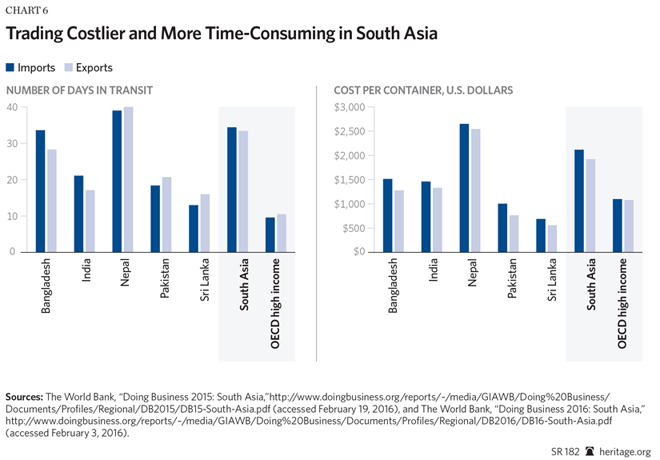
On the other hand, India and Pakistan import very little from the region, with India importing considerably more from Sri Lanka and Bangladesh than neighboring Pakistan, the second-largest economy in the region. Bilateral trade between the two countries is scant, but not for the lack of trade potential. Most credible estimates of potential annual trade between Pakistan and India range from about $10 billion to $20 billion,[29] whereas the 2014 figure for their bilateral trade was just $2.4 billion.
Lack of Regional Trade and Investment Integration Inhibits Inclusive Growth. Under the South Asian Free Trade Agreement (SAFTA), signed in 2006, each member country in the South Asian Association for Regional Cooperation (SAARC) area was offered tariff concessions under the SAARC’s Tariff Liberalization Programme. Least-developed countries (LDCs), such as Bangladesh and Nepal, enjoyed more concessions than the Non-LDCs. The sensitive-imports lists[30] under the agreement for non-LDCs were also smaller in size. For example, India’s sensitive list for Bangladesh had only 25 items, whereas its sensitive list for Pakistan and Sri Lanka included many more items: 614 in all. Pakistan, on the other hand has 936 items on its sensitive list for India (in addition to 1,209 product lines on its negative list that are not importable from India) for a total of more than 2,000 protected categories of imports).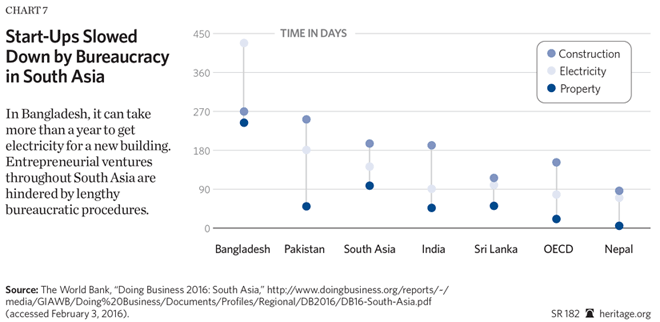
Despite repeated promises by the government in Islamabad that Pakistan would offer India most-favored-nation (MFN) status—now known as non-discriminatory market access (NDMA)—those promises have never materialized, and as a result, SAFTA tariff concessions have never completely kicked in, while a major list of items (mainly automotive and textile) under the negative list enjoy absolute protection by the government of Pakistan from Indian imports. Many of the Indian items on the negative list, while not formally importable, nevertheless still find their way into the Pakistani market either through informal channels, including smuggling, or by transiting through third countries.[31]
Non-tariff barriers (NTBs) are also a major deterrent to formal trade. These NTBs include difficult and lengthy customs procedures, infrastructure disabilities, and technical barriers to trade, such as standards certification, labelling and marketing regulations, packaging specifications, health and safety controls, tricky rules of origins, difficult and tedious banking and payment procedures, a restrictive visa regime that inhibits free movement of people, and many other bureaucratic obstacles.[32] Transport and transit are also major obstacles: Overland road routes are virtually nonexistent, and restrictions exist on the modes of transport permitted to export certain goods. For example, exports of Pakistani cement to India are allowed only by train and must be accompanied by cumbersome paperwork. Any trade by sea is bogged down with restrictions and charges—ships must first dock at a third-country port (such as Dubai or Singapore) before arriving in India.[33] Despite being signatories of the General Agreement on Tariffs and Trade’s Article V (Freedom of Transit), the two countries do not extend transit facility to each other.[34]
A Sustainability Development Policy Institute estimate puts the annual amount of informal trade flowing from India to Pakistan at nearly $1.8 billion and contends that as many as 11 indirect routes are used to conduct this trade. “Contrary to the existing perception, smuggling, and not quasi-legal trade through third country ports constitutes a majority of the trade.… The greatest volume of trade is carried out via Afghanistan. Other major routes are situated over land across the Sindh border and via sea from Mumbai to Karachi via Dubai.”[35] This black market trade adversely affects local manufacturing in Pakistan by providing an undue advantage to these duty-free products over local products. It also translates into lost tax revenue to the government.
A State Bank of Pakistan report echoes this finding:
The three important factors [in informal trade between Pakistan and India]: [1] quick realization of payments; [2] zero documentation; and [3] no procedural delays are contributing to lower transaction costs in the informal channel. The principal implication of this informal trade is that unless the environment of the formal trade improves, informal trade will not only continue to coexist with formal trade, but it will also impact its potential magnitude in the coming years.[36]
Going forward, then, it is obviously in the interest of Pakistan to take immediate and firm steps to increase the ratio of formal trade with India. The first step would be for Pakistan to extend MFN status to India, matching the granting of MFN status that India extended to Pakistan in 1996. Pakistan’s refusal to reciprocate is rooted in several long-standing and difficult political problems, with the disputed region of Kashmir being the most prominent.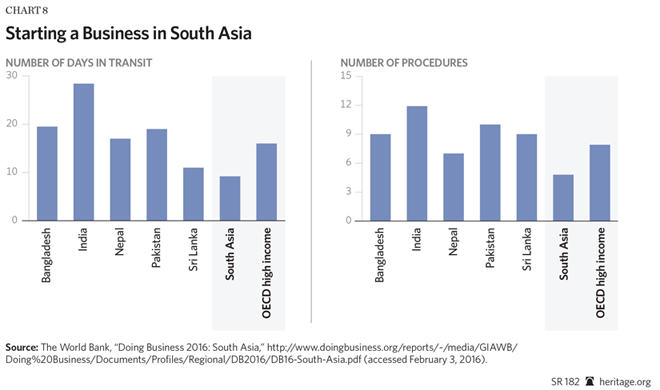
To date, neither side has been willing to budge on the Kashmir question. As a result, progress on any comprehensive dialogue on economic cooperation has been frozen. As a 2015 Heritage Foundation Special Report on economic freedom in Pakistan noted:
For years, the two countries have insisted on mixing trade negotiations with non-trade issues, with economic cooperation halting when political tensions intensified. As a consequence, trade talks have remained intermittent. Evidently, where trade might once have paved the way to better ties with India, it now may have become a negotiating chip for resolving other, larger issues between the two countries.[37]
This Pakistani intransigence has come at a cost. A recent Pew Research Center survey reveals that Pakistan is the least “favored” (or popular) nation in India, with 64 percent of respondents not hoping for better ties with the country and nearly 75 percent considering Pakistan a potent threat to India.[38] As far as opinion polls go, this survey not only reflects the mindsets of the majority of the Indian people, but also explains various decisions of the Indian government.
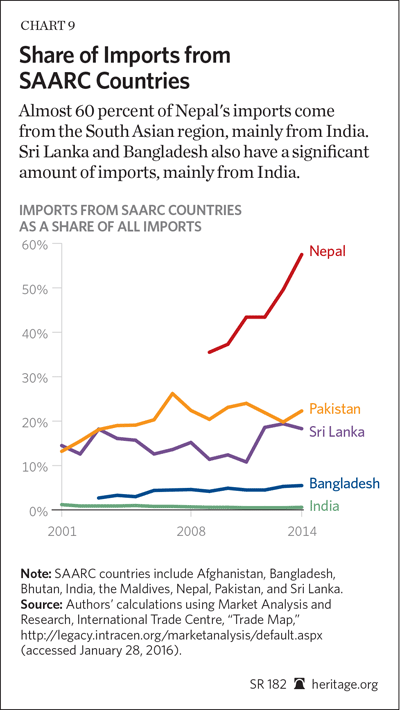 The upshot of the continuous and negative political rhetoric and actions from Pakistan, which has obstructed its trade normalization with India, has been to spur more bilateral linkages with countries in the region at the expense of more regional cooperation.
The upshot of the continuous and negative political rhetoric and actions from Pakistan, which has obstructed its trade normalization with India, has been to spur more bilateral linkages with countries in the region at the expense of more regional cooperation.
For example, India has free trade agreements (FTAs) with Sri Lanka and Nepal, has signed several agreements with Bangladesh, and is in trade negotiations with other smaller countries in South Asia. Nearly all products exported to India by Bangladesh, for example, enjoy duty-free market access in India.[39] Under the India–Sri Lanka FTA, India grants tariff concessions to Sri Lanka for product categories that are protected by the SAFTA sensitive list—undermining that regional agreement.
Pakistan, too, has an FTA with Sri Lanka and is in talks about one with Nepal. Meanwhile, SAFTA regional cooperation is pushed further to the back burner.
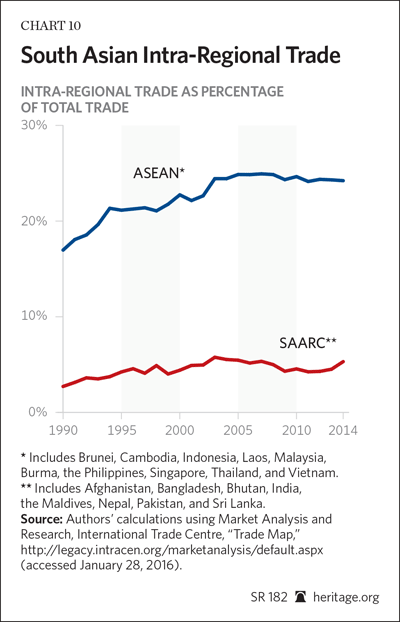 Although intra-regional trade[40] in South Asia moved from 2.9 percent[41] in 1990 to the 4 percent–5 percent range by about 2005, it has not changed much in the past decade, despite efforts in trade liberalization policy and the SAFTA regional trade agreement. Zahid Hussain, a World Bank economist, argues that regional convergence is absent in South Asia—where the region’s poorest country (Bangladesh) is growing faster than better-off countries such as Bhutan—because of the lack of regional integration. “Freeing the South Asian region from poverty and boosting shared prosperity will require addressing the barriers to intra-regional trade in goods, services, labor, and capital,”[42] Hussain contends.
Although intra-regional trade[40] in South Asia moved from 2.9 percent[41] in 1990 to the 4 percent–5 percent range by about 2005, it has not changed much in the past decade, despite efforts in trade liberalization policy and the SAFTA regional trade agreement. Zahid Hussain, a World Bank economist, argues that regional convergence is absent in South Asia—where the region’s poorest country (Bangladesh) is growing faster than better-off countries such as Bhutan—because of the lack of regional integration. “Freeing the South Asian region from poverty and boosting shared prosperity will require addressing the barriers to intra-regional trade in goods, services, labor, and capital,”[42] Hussain contends.
Despite the tariff cuts that it includes, overall, SAFTA was poorly negotiated by its member states. All too often, they dodged difficult political issues by granting tariff concessions only on products that had little, if any, trade potential. Meanwhile, all countries in the region continue to restrict trade in many “infant industry” sectors they deem to be too weak to fend off heavy regional competition. In India, this protectionism is manifested through para-tariffs on its SAFTA list of sensitive items.[43] In addition, there are a variety of NTBs in the SAFTA countries. Many NTBs have been erected by India, and unlike India’s other agreements—such as the ASEAN–India Comprehensive Economic Cooperation Agreement or the Asia–Pacific Trade (APEC) agreement, where India undertook to reduce NTBs—no such anti-NTB provision is included in SAFTA.[44] All of these constraints make trade less free.
To rectify this situation, the countries in South Asia must finish ratifying SAFTA—starting with Pakistan and India. SAFTA should be revised to include provisions requiring countries to eliminate NTBs. In addition, SAFTA should be amended to include a transit agreement that would improve connectivity between the South Asian countries and offer opportunities for greater infrastructure development.[45]
Any legitimate non-tariff measures that are related to health, security, or safety should be streamlined, reported, and addressed in a cohesive manner, relying on best practices already established in other world regions. For instance, under a grand Tripartite Free Trade Area between the Common Market for Eastern and Southern Africa (COMESA), the East African Community (EAC), and the Southern African Development Community (SADC), countries in that region have set up a mechanism to report, monitor, and remove NTBs that restrict trade. Under this agreement, private businesses are empowered to report an NTB to the regional COMESA secretariat while conducting business and tracking the progress of its resolution.[46]
Indian–Pakistan Cooperation Is Crucial for the Region. For the two largest countries in the region, the question of regional cooperation centers solely on whether the relationship between Pakistan and India can be salvaged. A 2013 Wilson Center study argues that better economic ties with India could fuel growth in Pakistan and that gains from trade should “outweigh geostrategic concerns.”[47] Pakistan should “expand the national security paradigm to include economic stability and trade,” the report recommends. The study also emphasizes the importance of reducing cross-border restrictions—such as the measures India has taken to allow movement of goods from Pakistan via Nepal, Bangladesh, and Bhutan, and what Pakistan has done to permit access of Indian goods via Afghanistan. In addition, the two countries must improve the efficiencies of trade routes by opening roads and railways to trade, improving infrastructure at border crossings, removing restrictions on transportation vehicles, and setting up better warehousing facilities.[48]
Pakistan stands to benefit not just from improved trade agreements and practices, but also from more liberalized investment regimes for foreign direct investment (FDI) inflows from India that would enable Pakistan to tap into the pool of India’s skilled workers and technology and thereby improve the global competitiveness of Pakistani industries.[49] In the pharmaceutical sector, for instance, Pakistan is burdened by high production costs that it could lower if Indian drug companies were permitted to invest in that sector and import their technical expertise. One encouraging recent development occurred when Biacon, a major player in the Indian pharmaceutical sector, granted an exclusive license to Pakistan’s Ferozpur Laboratory to market its drugs in Pakistan.[50] This could serve as a best-practice example for more investing collaborations.
Other studies project the gains that could result if these two geostrategically important countries could cooperate on more joint Indo–Pak projects for the production, trade, and delivery of energy. An Atlantic Council study claims that a joint hydroelectric power facility in the Indus Basin has the potential to generate 8,000 megawatts of power for the two sides. For energy-starved Pakistan, this is an opportunity worth considering. That study also suggests developing an oil and gas grid that would connect the oil-exporting Gulf nations to markets in India and Pakistan.[51] One such proposed project—the Iran–Pakistan–India gas pipeline—has been in negotiation for several years.
In 2011, a joint group of energy experts from both sides met to examine the feasibility of electricity trade. A broad understanding was reached between the National Transmission and Despatch Company (NTDC) in Pakistan and India’s Central Electricity Authority and Power Grid Corporation on the possibility of grid connectivity between Amritsar and Lahore to enable trade of up to 500 megawatts of power.[52] A Memorandum of Understanding was signed in 2014. Energy trade would provide relief to Pakistan, which is currently experiencing an energy crisis and chronic power shortages.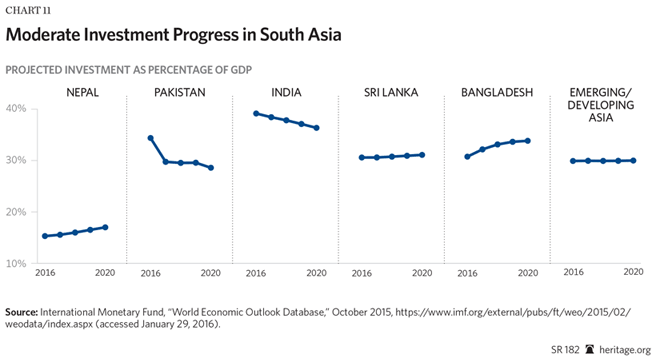
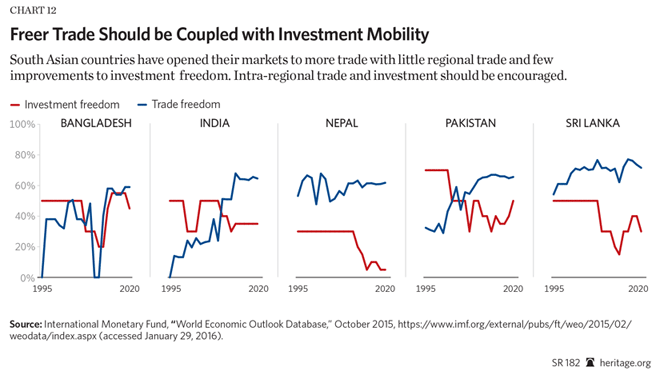 Yet another study, conducted by the Transnational Strategy Group, proposes the establishment of Pakistan–India cross-border special economic zones (SEZs) in the divided Punjab region that straddles the border between India and Pakistan that could facilitate trade.[53] Considering the security and border-related issues and trust deficits in the military and intelligence spheres of the two countries, this 2014 study realistically recommends that the two countries start with a pilot SEZ in which “investors and the two governments would work cooperatively to negotiate minimum regulatory and legal reforms, incentives and other policy-related measures that enterprises looking into potential investment in the SEZ need and that governments can, initially, provide.”[54]
Yet another study, conducted by the Transnational Strategy Group, proposes the establishment of Pakistan–India cross-border special economic zones (SEZs) in the divided Punjab region that straddles the border between India and Pakistan that could facilitate trade.[53] Considering the security and border-related issues and trust deficits in the military and intelligence spheres of the two countries, this 2014 study realistically recommends that the two countries start with a pilot SEZ in which “investors and the two governments would work cooperatively to negotiate minimum regulatory and legal reforms, incentives and other policy-related measures that enterprises looking into potential investment in the SEZ need and that governments can, initially, provide.”[54]
Improving the Investment Climate. While there have been marked improvements in trade freedom, investment freedom in South Asia shows little progress. Compared to emerging economies, investment as a percentage of GDP constitutes less than 30 percent for most South Asian economies, where India leads the region with an investment-to-GDP ratio of 32 percent.[55] FDI for the region has fallen considerably since 2005, going from $10.8 billion to $3.9 billion in 2014. According to a World Bank database, FDI as a percentage of GDP averages less than 2 percent in recent years for South Asia. India’s FDI was 1.7 percent of GDP in 2014, whereas the same was 0.7 percent for Pakistan and 0.9 percent for Bangladesh.[56] FDI inflows into South Asia originate predominantly from outside the region, where intra-regional investment is even less than intra-regional trade, and the potential for investment-to-trade linkages is severely lacking. Both Bangladesh and Sri Lanka have high, FDI-driven investment in the textile sector, while for Pakistan, the highest investments are in the energy and power sector (with the U.S. being the primary investor country). India is one of Nepal’s largest investors in the chemicals industry.[57] Recently, India has invested heavily in thermal-power-generation facilities in Bangladesh, investing about $2.5 billion in 2013 alone.[58]
India is also the largest recipient of FDI in the region (90 percent of all FDI), whereas other countries in the region are not known for investment attractiveness owing to widespread corruption, political instability, and weak political and institutional structures. Pakistan, for instance, has introduced policy reforms that provide fiscal benefits to foreign investors, such as credit facilities and foreign exchange easing; it could be an attractive market for foreign investors, but political instability makes it fairly unfavorable.[59]
An Asian Development Bank report on South Asia’s trade and investment regimes argues that the similarity in the levels of technology and cultures in South Asia and the region’s more labor-intensive production structures combine to generate greater incentives to trade and investment within the region than outside it.[60] This is another area where SAFTA needs improvement. While it contains a framework for intra-regional trade in South Asia, it does not extend that framework to investments, and it should.
IV. What Must South Asia Do?
The recent growth spurt in South Asian economies is fairly misleading and likely may not have long-lasting impact unless the region improves rule of law, introduces tough reforms to fight corruption, makes doing business easier, and creates pathways for regional connectivity and cooperation. Here are some specific steps South Asian countries should take:
- Combat corruption by increasing transparency and building accountability. Corruption and lack of transparency in public institutions is seen as the primary deterrent to foreign investments and doing business in South Asia. Right-to-information laws should be strengthened, and citizens’ requests for information from the state should be handled systematically and transparently. Anti-corruption agencies, including the judiciary, should be given complete independence and autonomy from the influence of the government, political, or military elite. Governments in South Asian countries—especially Nepal, Bangladesh, and Sri Lanka—should relinquish control of political appointments and no longer be allowed to transfer key decision-making positions to friends and family members. Such politically motivated appointments are known to have influenced decisions of these anti-corruption watchdogs.[61]
- Civil society, the media, and other non-state stakeholders should play an active role in applying pressure on their governments for sustainable accountability in society.[62]
- Introduce efficient regulatory reforms. Regulatory reforms to improve business, investments, and trade in South Asia are crucial for gaining global competiveness. Higher levels of regulation lead to inefficiency, and South Asia is an important example. The governments in South Asia must make processes easier for businesses by introducing automated systems, removing unnecessary procedural and administrative regulations that lead to delays and increased transaction costs. Processes must be streamlined to save time, and overall costs associated with bureaucracy should be reduced to make South Asia a thriving region for new businesses and investments.
- Boost regional connectivity through trade, investment, transport, and transit. Regional connectivity holds the baton for real and more sustainable growth in South Asia. Pakistan and India should allow normalization of trade and explore opportunities in trade, transit, and investment that come from shared borders and cultures, geographic proximity, and trade potential. The willingness of both countries to open their markets to each other would open a course for regional cooperation—something that can be accomplished under the current SAFTA. In fact, an empirical study shows that in terms of gains in both allocative efficiency and terms of trade, a fully implemented SAFTA would generate much larger welfare gains for India and Pakistan than those under a bilateral FTA between these two countries, and welfare gains for all South Asian countries would increase dramatically.[63] This would lead to stronger economic growth.The scope of SAFTA itself should also be expanded to facilitate transit trade and an improved investment climate while drawing a road map to address NTBs that have hindered trade in the past.
Conclusion
Countries with higher levels of economic freedom outperform others in reducing poverty, achieving greater prosperity, and ensuring broader progress in many dimensions of social and human development. As the Index of Economic Freedom has chronicled time and again, nations whose governments pursue policies that enhance economic freedom (such as through strengthening the rule of law, the promotion of competition and openness, or suitable restraints on the size and economic reach of government) are able to capitalize more fully on the ability of the free-market system not only to generate, but also to reinforce dynamic growth through efficient resource allocation, value creation, and innovation.
Although South Asian countries have enjoyed improved growth prospects recently thanks to the windfall resulting from lower oil prices, in order to sustain growth over the longer term, their governments must address the fundamental structural problems, regulatory inefficiencies, and endemic corruption that have blocked greater economic freedom. If they do correct these problems, they will foster a better life for their citizens and a more peaceful and prosperous world.
*About the Authors:
James M. Roberts is Research Fellow for Economic Freedom and Growth in the Center for Free Markets and Regulatory Reform, of the Institute for Economic Freedom and Opportunity, at The Heritage Foundation. Huma Sattar, of Karachi, Pakistan, is a former Visiting Scholar at The Heritage Foundation. Theodore Ellis, a member of the Young Leaders Program at The Heritage Foundation, made valuable contributions to this paper.
Source:
This article was published by The Heritage Foundation
Notes:
[1] The World Bank, “Forecast Table,” 2015, http://www.worldbank.org/en/publication/global-economic-prospects/summary-table (accessed November 9, 2015).
[2] Asian Development Bank, “Growth Prospects Soften for Developing Asia,” Asian Development Outlook Supplement, July 2015, http://www.adb.org/sites/default/files/publication/161734/ado-supplement-july-2015.pdf (accessed January 11, 2016).
[3] The World Bank, “Personal Remittances, Received (Current US$),” 2015, http://data.worldbank.org/indicator/BX.TRF.PWKR.CD.DT (accessed November 6, 2015).
[4] The World Bank, “Poverty and Equity,” 2015, http://povertydata.worldbank.org/poverty/region/SAS (accessed November 6, 2015).
[5] News release, “South Asia’s Corruption Watchdogs Need Sharper Teeth,” Transparency International, May 21, 2014, http://www.transparency.org/news/pressrelease/south_asias_corruption_watchdogs_need_sharper_teeth (accessed November 6, 2015).
[6] Transparency International, “Global Corruption Barometer,” 2015, http://www.transparency.org/gcb2013 (accessed November 6, 2015).
[7] Terry Miller and Anthony B. Kim, 2016 Index of Economic Freedom (Washington, DC: The Heritage Foundation and Dow Jones & Company, Inc., 2016), pp. 62–64, http://www.heritage.org/index/download.
[8] The World Bank, “Making the Most of Cheap Oil,” South Asia Economic Focus, Spring 2015, http://www.worldbank.org/content/dam/Worldbank/document/SAR/saef-final.pdf (accessed November 9, 2015).
[9] United Nations, “Table 1: Human Development Index and Its Components,” 2014, https://data.undp.org/dataset/Table-1-Human-Development-Index-and-its-components/myer-egms (accessed November 9, 2015).
[10] World Economic Forum, The Global Competitiveness Report: 2014–2015, 2014, p. 34, http://www3.weforum.org/docs/WEF_GlobalCompetitivenessReport_2014-15.pdf (accessed November 9, 2015).
[11] Huma Sattar, “Lack of Economic Freedom Will Hinder Nepal’s Recovery,” The Daily Signal, May 4, 2015, http://dailysignal.com/2015/05/04/lack-of-economic-freedom-will-hinder-nepals-recovery/.
[12] Gopakumar Krishnan Thampi, “Corruption in South Asia: Insights & Benchmarks from Citizen Feedback Surveys in Five Countries,” Transparency International, December 2002, http://unpan1.un.org/intradoc/groups/public/documents/APCITY/UNPAN019883.pdf (accessed November 6, 2015).
[13] Transparency International, “Daily Lives and Corruption: Public Opinion in South Asia,” http://www.transparency.org/whatwedo/publication/daily_lives_and_corruption_public_opinion_in_south_asia (accessed December 15, 2015).
[14] The Corruption Perceptions Index measures the perceived levels of public-sector corruption, scoring from 0 (highly corrupt) to 100 (very clean).
[15] Transparency International, 2014 Corruption Perceptions Index, 2015, https://www.transparency.org/cpi2014/results (accessed November 6, 2015).
[16] Transparency International, “Fighting Corruption in South Asia,” May 21, 2014, http://www.transparency.org/news/feature/fighting_corruption_in_south_asia (accessed November 6, 2015).
[17] Ibid.
[18] Transparency International, “Corruption Risks in Bangladesh,” 2013, https://www.transparency.org/files/content/feature/2014_CorruptionSouthAsia_factsheet_Bangladesh.pdf (accessed December 15, 2015).
[19] World Economic Forum, “The Global Competitiveness Report: 2014–2015.”
[20] Transparency International, “Global Corruption Barometer 2013,” http://www.transparency.org/gcb2013,” as cited in Transparency International Sri Lanka, “Corruption Risks in Sri Lanka,” 2014, https://www.transparency.org/files/content/feature/2014_CorruptionSouthAsia_factsheet_SriLanka.pdf (accessed December 15, 2015).
[21] World Economic Forum, The Global Competitiveness Report: 2014–2015, p. 34.
[22] Ibid.
[23] World Bank Group, “Doing Business 2015: Going Beyond Efficiency–Regional Profile 2015, South Asia (SA),” pp. 4–13, http://www.doingbusiness.org/reports/~/media/GIAWB/Doing%20Business/Documents/Profiles/Regional/DB2015/DB15-South-Asia.pdf (accessed November 9, 2015).
[24] An economy’s “distance to frontier” (DTF) score is calculated on a scale from 0 to 100, where 0 represents the worst performance and 100 represents the best performance, the frontier. DTF scores measure an economy’s absolute progress against the best practice “frontier” in each of the 10 regulatory areas.
[25] World Bank Group, “Doing Business: Business Reforms in South Asia,” 2015, http://www.doingbusiness.org/Reforms/Overview/Region/south-asia (accessed November 9, 2015).
[26] World Bank Group, “Doing Business 2015: Going Beyond Efficiency–Regional Profile 2015, South Asia (SA),” p. 68.
[27] Ibid., p. 20.
[28] International Trade Center, “Interregional and Intraregional Trade in Emerging Markets Identified as Key to Addressing Global Economic Crisis,” October 2012.
[29] Nisha Taneja et al., “Normalizing India Pakistan Trade,” Indian Council For Research on International Economic Relations, Working Paper No. 267, September 2013, http://icrier.org/pdf/working_paper_267.pdf (accessed January 14, 2016).
[30] These are lists of items that are not subject to any concessions; regular duties apply on trade in these items.
[31] Some of these items are fruits and vegetables, textiles, automobile parts, pharmaceutical products, tobacco, herbal products, spices and herbs, and paper products.
[32] Pakistan Business Council, Preliminary Analysis: Pakistan India Trade and a Viable Roadmap for Trade Liberalization, 2015, pp. 13–15, http://pbc.org.pk/wp-content/uploads/2014/06/Preliminary_Analysis_of_Pakistan_India_Trade-_PBC_2.pdf (accessed November 9, 2015).
[33] Selim Raihan and Prabir De, “India–Pakistan Economic Cooperation: Implications for Regional Integration in South Asia,” April 2013, p. 8, http://sanemnet.org/sanemafeefcontainer/uploads/2014/05/PS11953-5-India-Pakistan.pdf (accessed November 9, 2015).
[34] Ibid.
[35] “Study Sees $545m Informal Trade Between Pakistan, India in 2005,” The World Trade Review, June 2006, http://www.worldtradereview.com/news.asp?pType=N&iType=A&iID=133&siD=6&nID=27390 (accessed January 14, 2016).
[36] State Bank of Pakistan, “Implications of Liberalizing Trade and Investment with India,” in Trade Integration Between Pakistan and India, Chap. 2, 2006, http://www.sbp.org.pk/publications/pak-india-trade/Chap_2.pdf (accessed January 14, 2016).
[37] James Roberts and Huma Sattar, “Pakistan’s Economic Disarray and How to Fix It,” Heritage Foundation Special Report No. 172, June 30, 2015, http://www.heritage.org/research/reports/2015/06/pakistans-economic-disarray-and-how-to-fix-it.
[38] “Pakistan Remains Least Favoured Nation in India,” Dawn, September 18, 2015, http://www.dawn.com/news/1207663/pakistan-remains-least-favoured-nation-in-india (accessed November 9, 2015).
[39] Joyeeta Bhattacharjee, “India–Bangladesh Relations: Finding the Way Forward,” Observer Research Foundation, September 2014, http://www.observerindia.com/cms/sites/orfonline/modules/issuebrief/attachments/OI_43_1349686362951.pdf (accessed November 9, 2015).
[40] Intra-regional trade share is the percentage of intra-regional trade to total trade of the region, calculated using trade data. It is calculated as Tii/ Ti, where Tii is exports of region i to region i plus imports of region i from region i and Ti is total exports of region i to the world plus total imports of region i from the world. A higher share indicates a higher degree of dependence on regional trade.
[41] Asian Development Bank, Asia Regional Integration Center, “Integration Indicators,” https://aric.adb.org/integrationindicators (accessed November 9, 2015).
[42] Zahid Hussain, “What Drags Poverty Reduction in South Asia?” The World Bank, August 5, 2013, http://blogs.worldbank.org/endpovertyinsouthasia/what-drags-poverty-reduction-south-asia (accessed November 9, 2015).
[43] Additional tariffs on top of basic duties.
[44] Asian Development Bank, Asia Regional Integration Center, “Free Trade Agreements,” http://aric.adb.org/fta-comparative-chapters?fta%5B0%5D=3&fta%5B1%5D=13&fta%5B2%5D=64&fta%5B3%5D=71&fta%5B4%5D=137&fta%5B5%5D=83&chapter%5B0%5D=14&chapter%5B1%5D=15 (accessed November 9, 2015).
[45] Rajiv Kumar and Manjeeta Singh, “India’s Role in South Asia Trade and Investment Integration,” Asian Development Bank Working Paper Series on Regional Economic Integration, No. 32, July 2009, http://www.adb.org/sites/default/files/publication/28506/wp32-india-role-south-asia-trade.pdf (accessed November 9, 2015).
[46] Non-Tariff Barriers, “Resolved Complaints: TradeMark Southern Africa,” 2015, http://www.tradebarriers.org/resolved_complaints (accessed November 9, 2015).
[47] Michael Kugelman and Robert M. Hathaway, eds., The Pakistan–India Trade Relationship: Prospects, Profits, and Pitfalls, The Wilson Center, 2013, p. 10, https://www.wilsoncenter.org/sites/default/files/ASIA_121219_Pakistn%20India%20Trade%20rptFINAL.pdf (accessed November 9, 2015).
[48] Ibid., pp. 12–13.
[49] Ijaz Nabi, “Pakistan’s Trade with India: Thinking Strategically,” in Kugelman and Hathaway, eds., The Pakistan–India Trade Relationship: Prospects, Profits, and Pitfalls, p. 44.
[50] Palakh Jain and Samridhi Bimal, “Enhancing India–Pakistan Economic Cooperation: Prospects for Indian Investment in Pakistan,” Indian Council for Research on International Economic Relations Working Paper No. 274, May 2014, http://icrier.org/pdf/working_paper_274.pdf (accessed November 9, 2015).
[51] Shuja Nawaz and Mohan Guruswamy, “India and Pakistan: The Opportunity Cost of Conflict,” Atlantic Council, South Asian Center, 2014, http://www.atlanticcouncil.org/publications/reports/india-and-pakistan-the-opportunity-cost-of-conflict (accessed November 9, 2015).
[52] Jain and Bimal, “Enhancing India–Pakistan Economic Cooperation: Prospects for Indian Investment in Pakistan.”
[53] Transnational Strategy Group, “Study of the Benefits of Establishing a Pakistan-India Cross-Border Special Economic Zone (SEZ),” November 2014, http://transnationalstrategy.com/pakistan-india-special-economic-zone-sez-study/ (accessed November 9, 2015).
[54] Ibid.
[55] International Monetary Fund, “World Economic Outlook,” October 2015, https://www.imf.org/external/pubs/ft/weo/2015/02/weodata/index.aspx (accessed December 15, 2015).
[56] The World Bank, “Data,” 2015, http://data.worldbank.org/ (accessed December 15, 2015).
[57] International Trade Center, “Investment Map,” 2012, http://www.investmentmap.org/ (accessed November 9, 2015).
[58] Monish Gulati, “Sushma Visit Gives Fresh Impetus to India–Bangladesh Ties,” South Asia Monitor, June 30, 2014, http://southasiamonitor.org/detail.php?type=sl&nid=8437 (accessed November 9, 2015).
[59] Jain and Bimal, “Enhancing India–Pakistan Economic Cooperation: Prospects for Indian Investment in Pakistan.”
[60] Asian Development Bank, “Study on Intraregional Trade and Investment in South Asia,” 2009, http://www.adb.org/sites/default/files/publication/28658/intraregional-trade-investment.pdf (accessed December 15, 2015).
[61] Transparency International, “Fighting Corruption in South Asia,” May 21, 2014, http://www.transparency.org/news/feature/fighting_corruption_in_south_asia (accessed November 6, 2015).
[62] Ibid.
[63] Selim Raihan and Prabir De, “India–Pakistan Economic Cooperation: Implications for Regional Integration in South Asia,” Commonwealth Secretariat, revised draft, April 2013, http://sanemnet.org/sanemafeefcontainer/uploads/2014/05/PS11953-5-India-Pakistan.pdf (accessed November 9, 2015).

